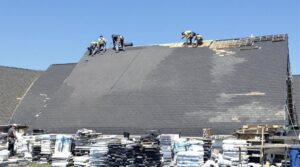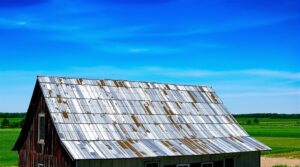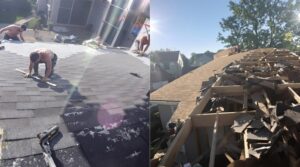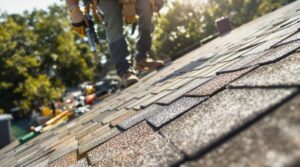Is your roof crying out for help? Let's tackle the age-old dilemma of restoration vs. replacement head-on! Think of your roof like a favorite old jacket – sometimes it just needs a good patch-up, while other times it's ready for retirement.
Roof restoration works like a spa day for your shingles, breathing new life into your existing coverage through strategic repairs and protective coatings. The best part? You'll save a whopping 50-70% compared to a full replacement, keeping both your roof and wallet happy.
But when should you restore, and when is it time to start fresh? Picture this: if your roof has minor battle scars or isolated damage (like that one stubborn leak), restoration might be your golden ticket. However, if you're dealing with structural issues that make your roof look like a weathered battlefield, replacement becomes your safest bet.
Don't play the guessing game – get a professional roofer to assess your situation. They'll consider crucial factors like:
- Material durability and age
- Environmental impact
- Insurance implications
- Current structural integrity
- Local climate conditions
By weighing these elements against your budget and long-term goals, you'll make an informed decision that protects your home and investment. Remember, your roof isn't just a cover – it's your home's first line of defense against Mother Nature's mood swings!
Key Takeaways
Let's Talk Roof Revival vs. Complete Overhaul – What's Best for Your Home?
Ever wondered whether your aging roof needs a facelift or major surgery? Think of roof restoration as a spa day for your shingles – it's like giving your roof a rejuvenating treatment that costs roughly half of what you'd spend on a full replacement. While you might shell out $7,000-$12,000 for restoration, a complete replacement could set you back anywhere from $15,000 to $50,000.
Is your roof showing signs of wear and tear? Minor leaks and surface damage are perfect candidates for restoration – it's like applying medicine to a scratch rather than amputating the whole limb. But when your roof's got serious structural issues or widespread decay, replacement becomes your only lifeline.
Going green with your roof decisions? Restoration is your eco-warrior choice. Each commercial roof replacement sends about 100,000 pounds of material to our landfills – that's equivalent to the weight of eight adult elephants!
But here's the plot twist: if you're hunting for maximum energy savings and property value boost, a fresh new roof might be your golden ticket. It's like upgrading from an old flip phone to the latest smartphone – you'll get better performance and more features.
Want to know the real kicker? Your roofing material choice is like picking a life partner – some relationships last longer than others. Slate roofs can stick around for a century, while other materials might give you 20-50 years of faithful service with proper TLC. Choose wisely!
Understanding the Key Differences
The distinction between roof restoration and replacement represents a significant decision point for property owners facing roofing issues. Restoration focuses on extending roof lifespan through targeted repairs and protective coatings, while replacement involves complete removal and installation of new materials.
Restoration maintenance strategies encompass cleaning, repairing damaged sections, and applying protective coatings to preserve existing structures. This approach proves suitable for roofs with minor wear but sound underlying condition.
However, restoration has limitations, particularly regarding structural issues or extensive damage. The process offers less disruption to daily activities and demonstrates environmental consciousness by avoiding complete material disposal.
Professional assessment remains essential in determining whether restoration can effectively address the roof's condition or if replacement presents the necessary solution for long-term durability and protection.
With restoration costing 50-70% less than full replacement, property owners can achieve significant savings while maintaining structural integrity.
Cost Analysis and Financial Impact
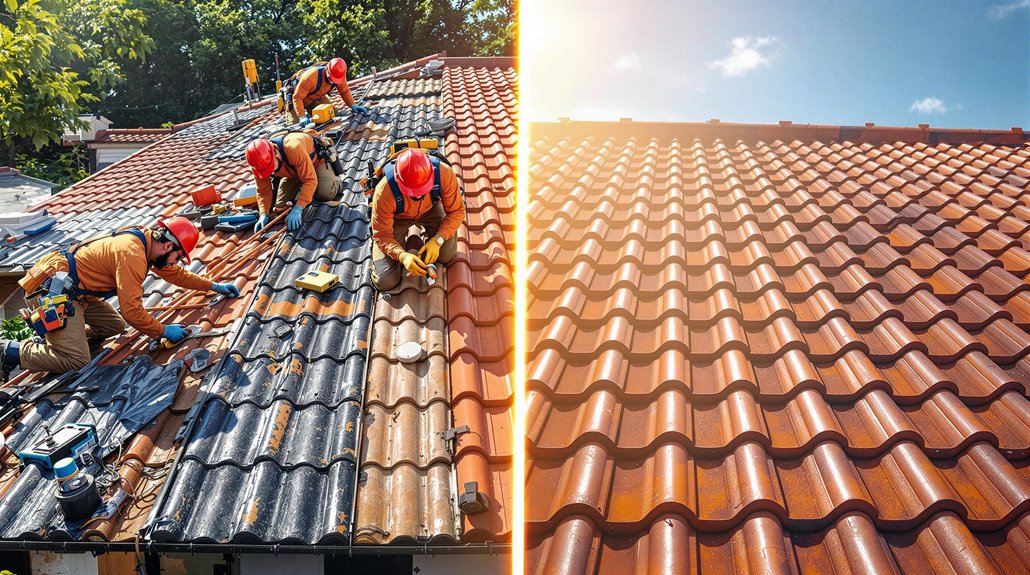
The initial investment for roof restoration typically ranges 50-70% lower than complete replacement costs, with restoration projects averaging $7,000-$12,000 compared to replacement costs of $15,000-$50,000 depending on materials selected.
Financial analysis indicates that while restoration offers immediate cost advantages, the cumulative expenses of multiple restorations could eventually exceed a single replacement cost, particularly for aging roofs requiring frequent repairs.
The long-term savings potential of each option depends on factors such as roof condition, material durability, and energy efficiency improvements, with new replacements often providing superior energy cost reductions and increased property values over time.
Working with public adjusters can increase insurance settlements by 40-350% when pursuing coverage for major roof work.
Initial Investment Breakdown
Understanding initial investment costs represents a crucial factor when deciding between roof restoration and replacement options. Investment strategies must account for both immediate expenses and potential long-term financial implications.
Restoration costs primarily depend on damage extent, material selection, and labor requirements, with repairs ranging from $150 to $3,000. Replacement expenses, however, can range from $7,000 to $50,000, influenced by roof size, complexity, and material choice.
Cost forecasting should consider that labor typically comprises 60% of total expenses, with regional variations affecting overall costs. While restoration offers lower upfront investments, replacement often provides enhanced energy efficiency and reduced maintenance costs over time.
The decision ultimately balances budget constraints against long-term value, considering factors such as climate conditions and building code compliance requirements. Professional roofers must utilize specialized safety equipment including harnesses and fall protection systems that add significant overhead to project costs.
Long-Term Savings Potential
Beyond initial costs, analyzing long-term savings potential provides stakeholders with extensive financial insights when choosing between roof restoration and replacement. Financial forecasting reveals that cumulative repair expenses often exceed replacement costs over time, affecting roof longevity and overall investment value. Energy efficiency improvements from new installations generate substantial utility savings, while reduced maintenance needs stabilize long-term expenditures. Working with public adjusters increases settlements by up to 800% compared to self-filing insurance claims.
| Factor | Restoration | Replacement |
|---|---|---|
| Energy Efficiency | Moderate Improvement | Maximum Efficiency |
| Maintenance Costs | Periodic Repairs | Minimal for 15-20 Years |
| Property Value | Short-Term Boost | Long-Term Enhancement |
Critical evaluation of cost-benefit factors, including warranty coverage, climate impact, and material durability, enables property owners to make informed decisions aligned with their financial objectives. This thorough analysis considers both immediate expenses and future cost implications.
Environmental Benefits and Sustainability
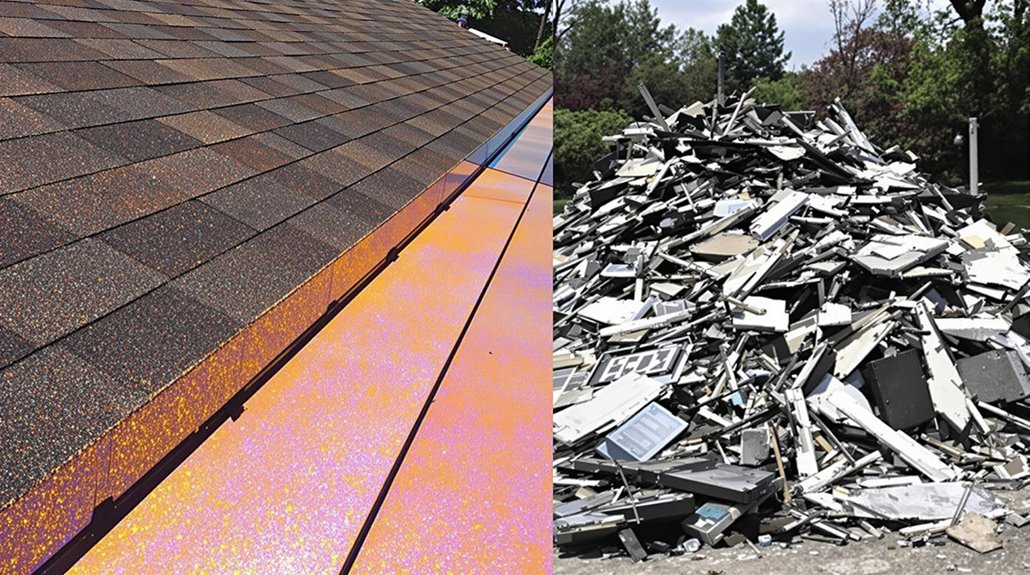
The environmental impact of roofing decisions greatly affects landfill waste, with restoration methods producing substantially less waste compared to complete replacements that generate millions of tons of discarded materials annually.
Modern roof restoration techniques incorporate eco-friendly materials and reflective coatings that enhance energy efficiency while minimizing environmental footprint.
When replacement becomes necessary, sustainable options such as recyclable metal roofing, recycled composite shingles, and natural slate tiles offer environmentally conscious alternatives that reduce landfill impact and support long-term sustainability goals.
Reduced Landfill Impact
While environmental concerns continue to shape modern construction practices, roofing waste has emerged as a significant contributor to landfill congestion, with nearly 10% of U.S. landfill space consumed by discarded roofing materials over the past four decades.
The impact becomes evident when considering that a single 12,000-square-foot commercial roof replacement generates approximately 100,000 pounds of waste, requiring up to 10 dumpsters for disposal.
Waste reduction through restoration presents a sustainable practice that effectively minimizes landfill impact.
- A typical commercial roof replacement produces 7,000-10,000 pounds of waste per dumpster
- Restoration utilizes existing roof systems, eliminating immediate tear-off waste
- Multiple restoration cycles can extend roof life for decades, delaying replacement needs
- Sustainable practices through restoration reduce cumulative waste over time
Consulting with insurance providers about policy coverage limits can help determine whether restoration or replacement is the most cost-effective solution for your roofing needs.
Green Material Options
Modern sustainable roofing practices have evolved to incorporate environmentally conscious materials and designs that deliver substantial ecological benefits.
Green roof benefits include significant improvements in air quality through the filtration of pollutants and reduction of greenhouse gas emissions. These sustainable materials contribute to efficient water management by retaining 70-90% of summer precipitation and 25-40% in winter months.
The implementation of green roofing systems promotes energy efficiency by moderating indoor temperatures and reducing urban heat-island effects.
Additionally, these installations enhance biodiversity by creating wildlife habitats while serving multiple functions as community spaces.
The materials used in green roofs act as natural water filters, delay stormwater runoff, and decrease the strain on municipal sewer systems during peak periods, making them an environmentally responsible choice for modern construction.
Signs That Help You Choose Between Options
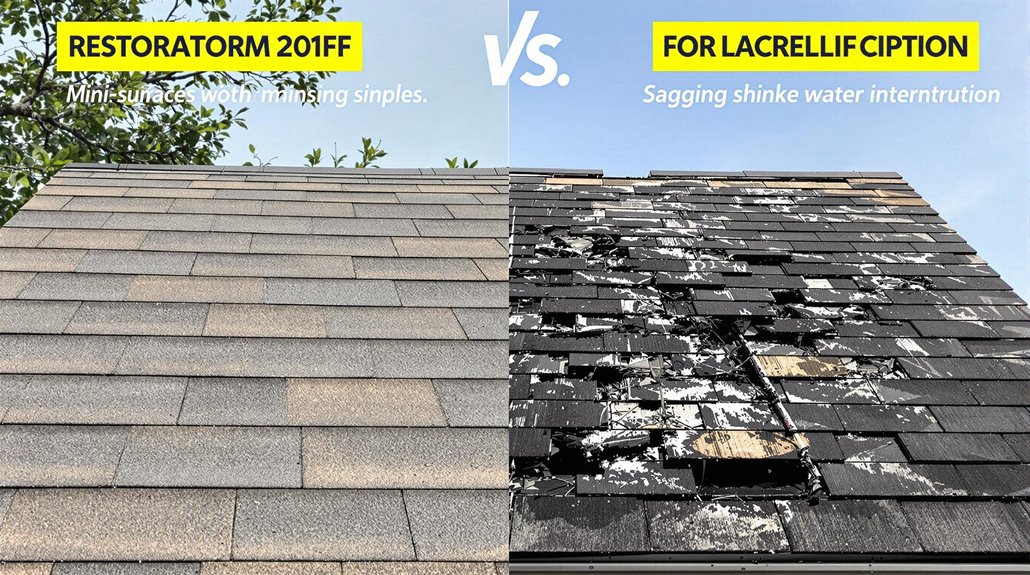
Determining whether to restore or replace a roof requires careful evaluation of specific indicators that point toward the most appropriate solution. The roof age and leak severity are primary factors, with restoration being suitable for roofs within their expected lifespan showing minor deterioration, while replacement becomes necessary for older roofs with extensive damage.
A systematic assessment of key signs helps property owners make informed decisions about their roofing needs.
- Restoration indicators include surface deterioration, minor leaks, isolated missing shingles, and cosmetic issues like discoloration.
- Replacement signs encompass structural sagging, multiple severe leaks, widespread shingle damage, and significant water intrusion.
- The presence of mold, extensive water damage, or compromised structural integrity typically necessitates replacement.
- Cost-effectiveness analysis comparing long-term benefits versus immediate expenses guides the final decision.
Professional assessments show that repairs are viable when damage affects 30% or less of the total roof surface.
Material Options and Their Longevity
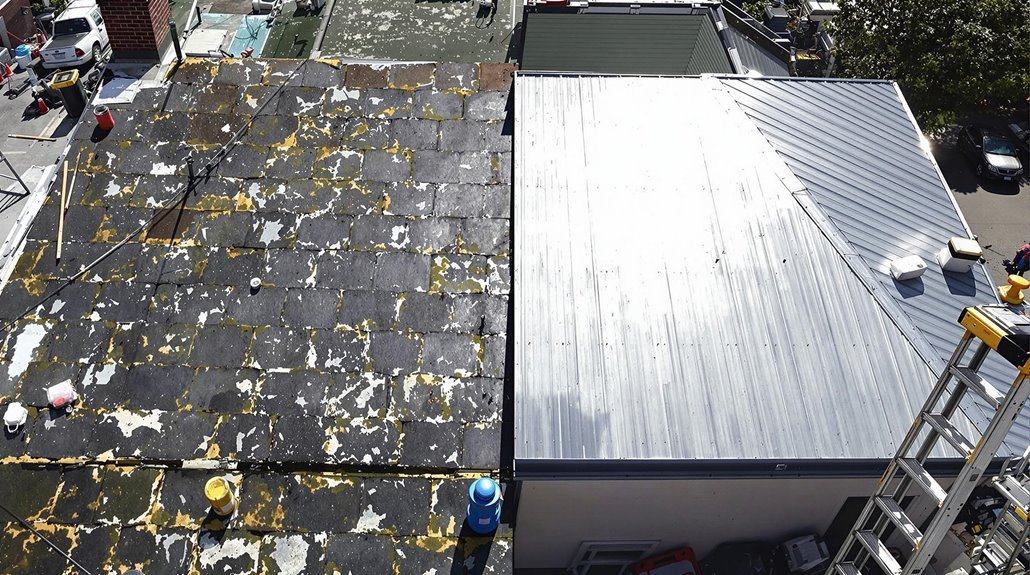
The selection of roofing materials greatly influences both restoration and replacement outcomes, with each option offering distinct longevity characteristics. Material durability varies considerably, with slate roofs demonstrating the longest potential lifespan of up to 100 years when properly maintained.
Restoration techniques can extend the life of existing roofs by 5-15 years, depending on the material type, while complete replacements offer new lifespans ranging from 20-50 years or more.
Metal and slate materials consistently show superior longevity in both restoration and replacement scenarios. While asphalt shingles represent a more economical choice with shorter durability, copper roofs offer exceptional lifespan potential but at premium costs.
The effectiveness of either restoration or replacement largely depends on proper maintenance protocols and the original material's quality, making these factors essential in the decision-making process. For asphalt shingles specifically, insurance providers apply a 5% annual depreciation when calculating coverage and replacement values.
The Role of Professional Assessment
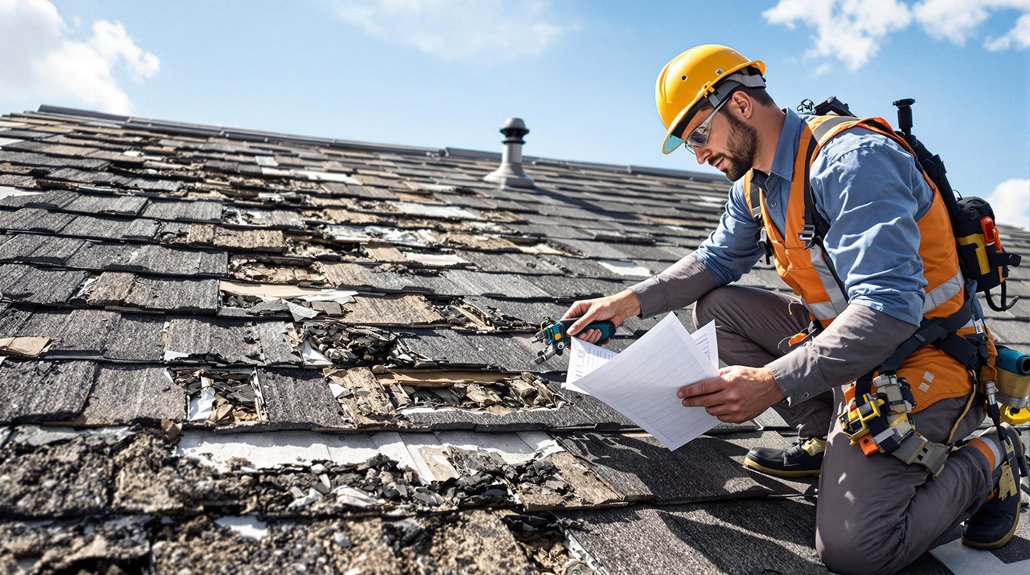
Professional assessment serves as a critical foundation for making informed decisions about roof restoration or replacement, encompassing extensive evaluations of structural integrity, material conditions, and potential damage.
Certified inspectors utilize advanced assessment methodologies to detect both visible and concealed issues, providing thorough documentation essential for insurance claims and project planning.
Professional credentials, such as National Roof Certification and Inspection Association certification, guarantee adherence to industry standards and reliable outcomes.
- Early detection capabilities through specialized equipment and expertise
- Detailed documentation and reporting for insurance and decision-making purposes
- Expert evaluation of restoration versus replacement options based on damage severity
- Implementation of safety protocols and quality control measures during inspection
These systematic assessments enable property owners to make cost-effective decisions while maintaining structural integrity and extending roof longevity.
Having a licensed public adjuster participate in the assessment process can significantly improve insurance claim outcomes and ensure fair compensation for roof damage.
Seasonal Timing and Weather Considerations
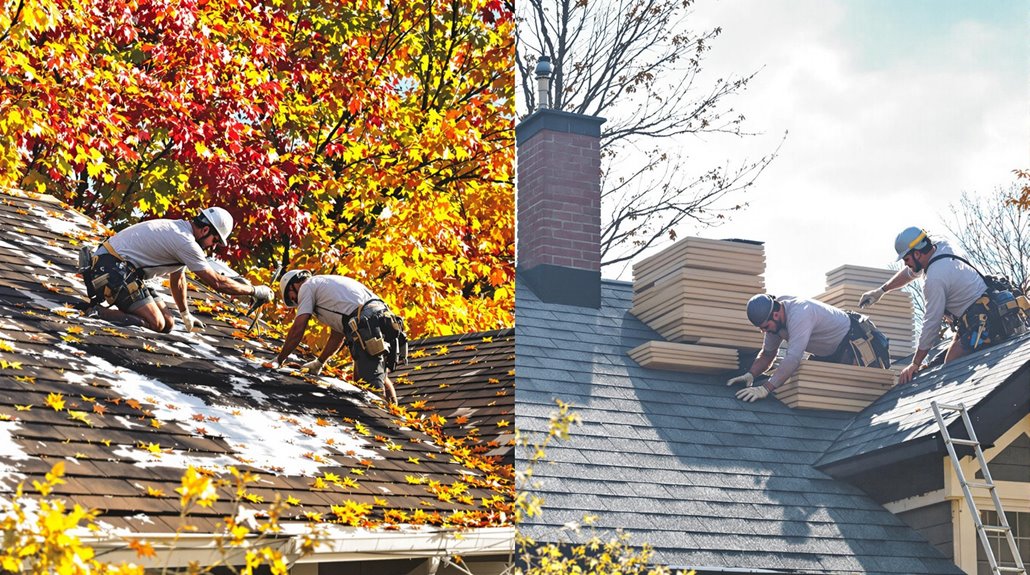
Selecting ideal seasonal timing for roof work greatly influences project success, cost-effectiveness, and durability of installations. Different seasons present distinct seasonal advantages and weather impact factors that affect material performance and worker safety. Understanding these variables enables the best project scheduling.
| Season | Key Advantages | Primary Challenges |
|---|---|---|
| Spring | Mild temperatures, contractor availability | Occasional rain delays |
| Summer | Long daylight hours, predictable weather | Heat affects materials |
| Fall | Best temperature range, proper sealing | High contractor demand |
Temperature particularly influences material behavior, with ideal conditions between 45-85 degrees Fahrenheit for proper adhesion and durability. Rain, humidity, wind, and snow can compromise installation quality and worker safety. Fall generally offers the most favorable conditions, while winter presents significant challenges despite potential cost savings.
Safety and Building Code Compliance
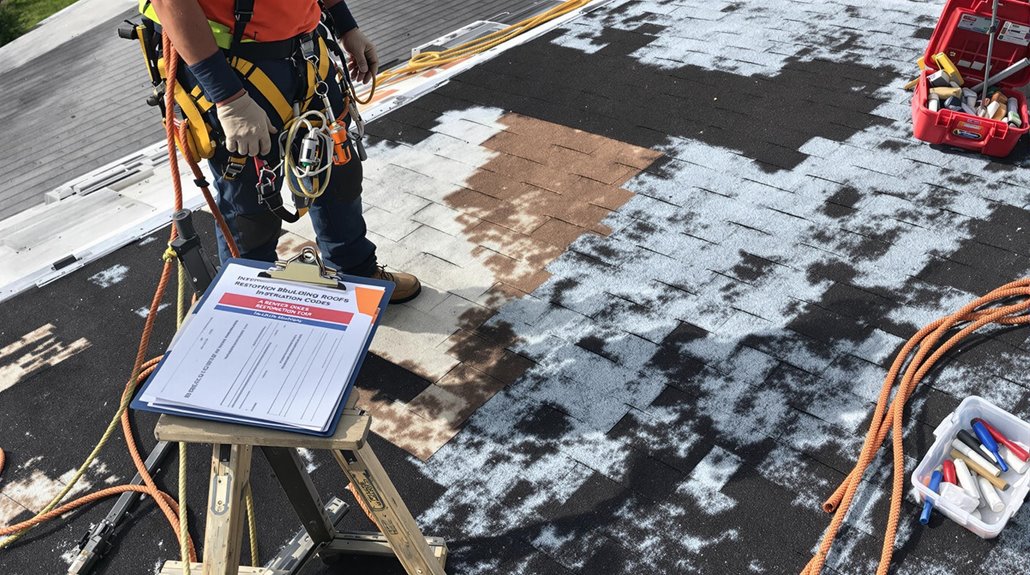
Beyond seasonal timing considerations, safety protocols and building code compliance form the foundation of successful roofing projects. Regular roof inspections and compliance audits guarantee structural integrity while preventing costly repairs and potential hazards.
Professional assessment becomes essential in determining whether restoration or replacement aligns with local building regulations.
- Building codes typically restrict multiple roofing layers due to weight limitations and structural concerns
- Non-compliance can result in legal penalties, insurance claim denials, and increased safety risks
- Professional contractors must verify material compatibility with existing structures
- Regular maintenance and inspection schedules help maintain ongoing code compliance
Adherence to building codes not only guarantees safety but also protects property value and minimizes liability risks.
Professional contractors play a significant role in maintaining these standards through proper implementation and documentation of all roofing work.
Public adjusters can increase insurance claim payouts by 20-50% when structural issues are identified during inspections.
The Benefits Of Consulting A Public Adjuster
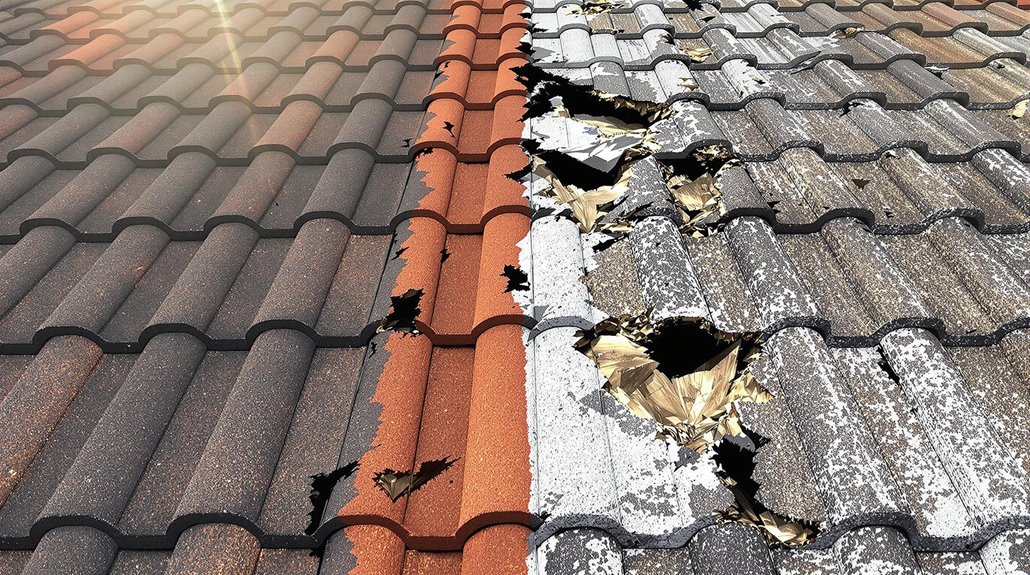
Public adjusters provide essential expertise in maneuvering complex insurance claims while conducting thorough, objective assessments of roof damage that insurance company adjusters might overlook.
Their professional representation streamlines the entire claims process by managing documentation, communication, and negotiation with insurance providers.
Statistical evidence indicates that utilizing a public adjuster's services can result in considerably higher claim settlements, with studies showing increases of up to 747% compared to unrepresented claims.
For maximum benefit, homeowners should engage public adjuster services before having significant discussions with their insurance company or accepting any settlement offers.
Expertise In Insurance Claims
When dealing with roof damage insurance claims, consulting a public adjuster can greatly improve the outcome of the settlement process. Public adjusters possess extensive knowledge of insurance policies and procedures, enabling them to navigate complex claim documentation and implement effective negotiation strategies.
Their expertise helps identify overlooked damages while ensuring thorough coverage under the policy terms. Professional adjusters manage the entire claims process, from initial inspection to final settlement, reducing stress and time investment for property owners.
- Interprets policy language to maximize entitled benefits
- Prepares detailed documentation of all damages and losses
- Communicates effectively with insurance company representatives
- Negotiates settlements that are typically higher than self-filed claims
This specialized expertise often results in settlements three to five times higher than those achieved without professional assistance, ensuring property owners receive fair compensation for roof damages and necessary repairs.
Objective Damage Assessment
Conducting an objective damage assessment through a qualified public adjuster provides property owners with thorough documentation and accurate evaluation of roof-related issues. Public adjusters utilize expert knowledge and systematic approaches to guarantee comprehensive claim accuracy, preventing potential underestimation of damages by insurance companies.
The damage evaluation process encompasses meticulous documentation through detailed photographs, technical reports, and professional analysis of both visible and hidden structural issues.
This impartial assessment serves as vital evidence for insurance claims, often revealing additional damage that might otherwise go unnoticed. By leveraging their extensive understanding of policy terms and industry standards, public adjusters deliver unbiased evaluations that strengthen the property owner's position during settlement negotiations, ultimately leading to more equitable compensation for roof-related damages.
Streamlined Claim Process
Engaging a public adjuster greatly streamlines the insurance claim process through systematic documentation, expert negotiation, and efficient case management.
These professionals enhance claim efficiency by facilitating organized communication between homeowners and insurance providers while ensuring regulatory compliance throughout the process. Their specialized knowledge of insurance policies and claim procedures enables swift resolution through meticulous paperwork organization and thorough damage assessment.
- Expedites initial response and documentation to prevent further property deterioration
- Manages all communication channels to minimize delays and misunderstandings
- Implements systematic tracking procedures to monitor claim progress
- Provides professional advocacy to protect homeowner interests during negotiations
Public adjusters maintain focused follow-up protocols and leverage industry connections to expedite claim resolution, ultimately reducing stress for property owners while ensuring ideal outcomes through their objective guidance and expertise.
Higher Claim Payouts & Settlements
The expertise of public adjusters considerably amplifies insurance claim payouts through methodical assessment, strategic negotiations, and extensive documentation practices.
These licensed professionals employ proven claim strategies to secure settlements that are often three to five times higher than those obtained without professional representation.
Operating independently from insurance companies, public adjusters utilize sophisticated negotiation tactics while managing all aspects of the claims process.
Their thorough approach includes detailed damage assessments, evidence compilation, and strategic policy interpretation.
Working on a contingency basis, typically under 10% of the settlement, they provide their expertise without upfront costs.
Their state licensure and deep understanding of insurance regulations guarantee compliance while maximizing claim recovery through established industry standards and documented substantiation.
About The Public Claims Adjusters Network (PCAN)
Professional claims management reaches new heights through the Public Claims Adjusters Network (PCAN), a detailed organization of licensed adjusters operating across all 50 states and internationally.
The Adjuster Network leverages sophisticated claim processing technology and extensive expertise in damage assessment, policy interpretation, and settlement negotiations.
- Licensed professionals with extensive experience in construction, repair, and business interruption calculations
- Advanced technological systems for accurate claim documentation and estimation
- Client-focused approach with tailored solutions for residential and commercial properties
- Risk-free service model with payment contingent upon successful settlements
PCAN maintains high professional standards through certified expertise, offering immediate support during emergencies and maintaining a robust network of legal and financial specialists to achieve the best claim outcomes for policyholders.
Frequently Asked Questions
How Long Does a Typical Roof Restoration Project Take to Complete?
A typical roof restoration timeline spans one to four weeks, depending on project phases, roof size, and complexity. Small residential projects average 3-7 days, while larger commercial projects require 2-4 weeks.
Can I Stay in My Home During Roof Restoration Work?
Like many homeowners, residents can remain in their homes during roof restoration, though they should monitor noise levels and address safety concerns regarding falling debris and equipment operation.
Will Restoration or Replacement Affect My Home Insurance Premiums?
Roof replacement typically results in more significant insurance coverage benefits and premium adjustments compared to restoration. New roofs can reduce premiums by 5-20%, while restoration generally maintains existing premium rates.
Are There Financing Options Available for Both Restoration and Replacement?
Multiple financing plans exist for both projects, including home equity loans, personal loans, contractor financing, and credit cards. Cost comparisons indicate restoration typically requires less financing than complete replacement.
What Happens if It Rains During My Roof Restoration Project?
Despite common concerns, professional roofers utilize tarping and sectional work strategies to minimize rain damage. While project delays may occur, contractors implement preventive measures to protect exposed areas during restoration work.
References
- https://www.duluxroofing.com.au/roof-restoration-tips/roof-restoration-vs-roof-replacement
- https://www.angi.com/articles/how-much-do-roof-repairs-cost.htm
- https://www.talbotcompanies.com/blog/what-is-the-difference-between-roof-restoration-recover-and-replacement
- https://www.stevensroofingcorp.com/blog/roof-revamp-roof-restoration-vs-roof-replacement
- https://www.improveitmd.com/blog/how-much-does-a-maryland-roof-replacement-cost
- https://www.larsonkeeneyhomeservices.com/roof-repair-vs-roof-restoration/
- https://amazingarchitecture.com/articles/roof-restoration-vs-replacement-which-one-is-better
- https://roofmaxx.com/learning-hub/roof-replacement-vs-restoration/
- https://bayvalleyroofing.com/blog/roof-repair-cost/
- https://www.renovaroofing.com/blogs/roof-restoration-cost/
